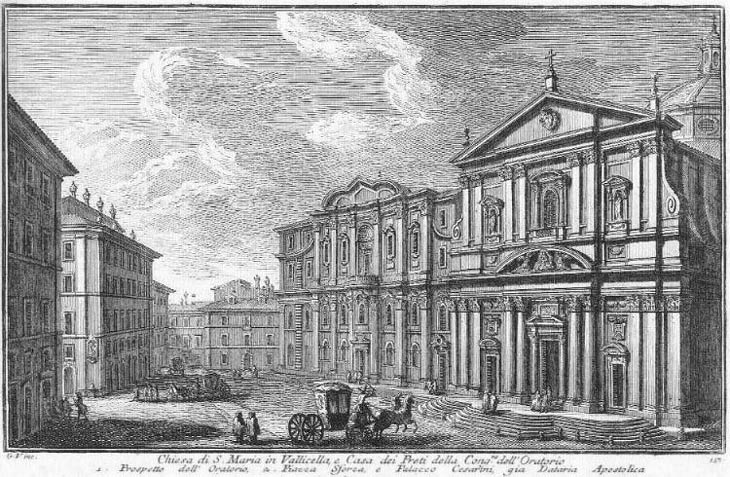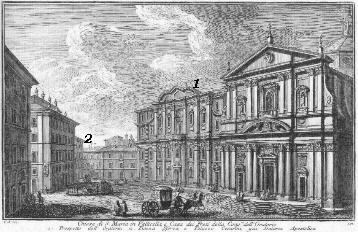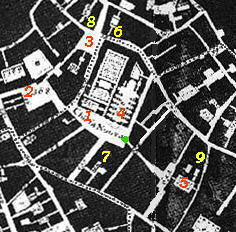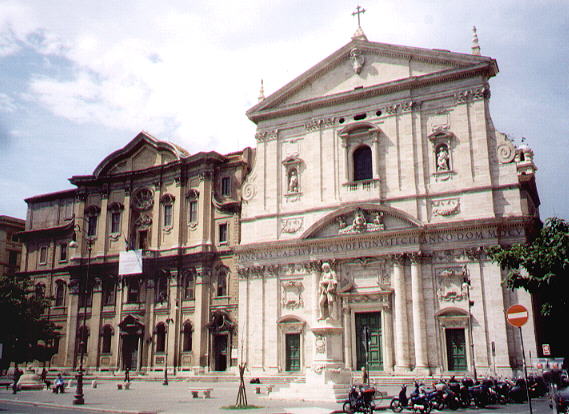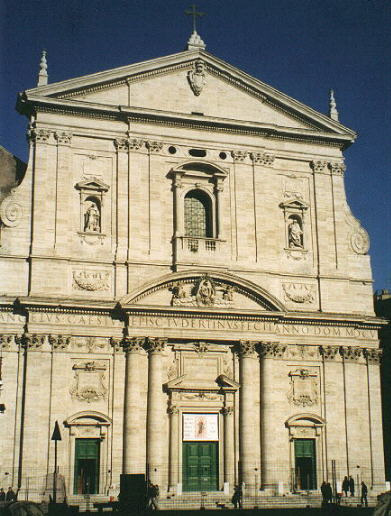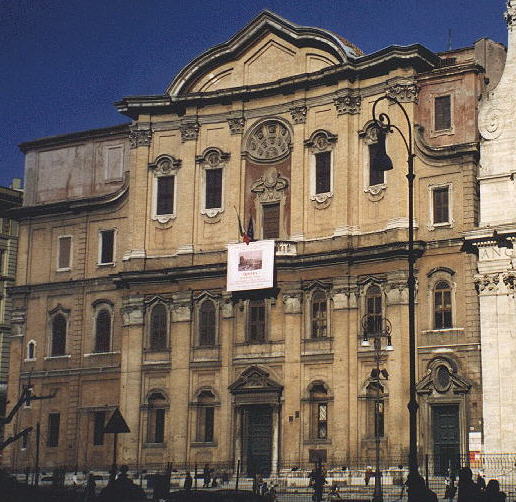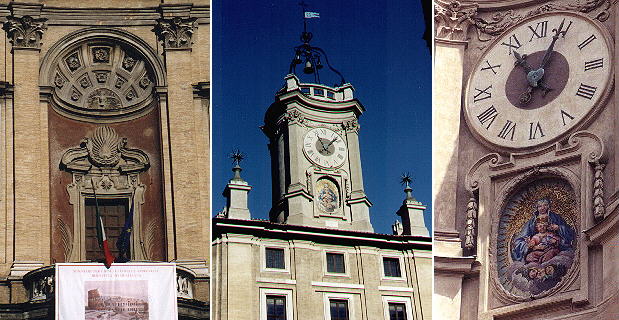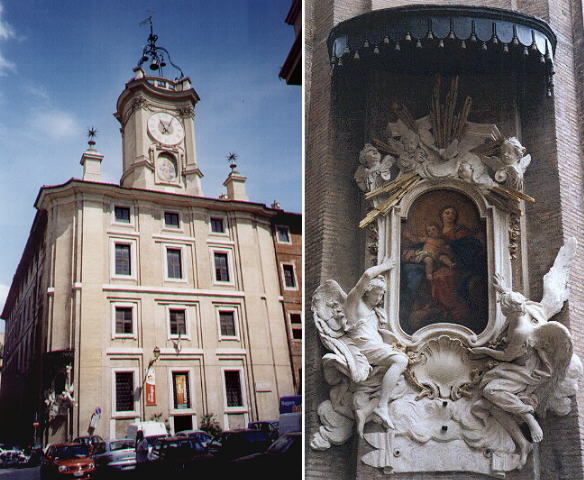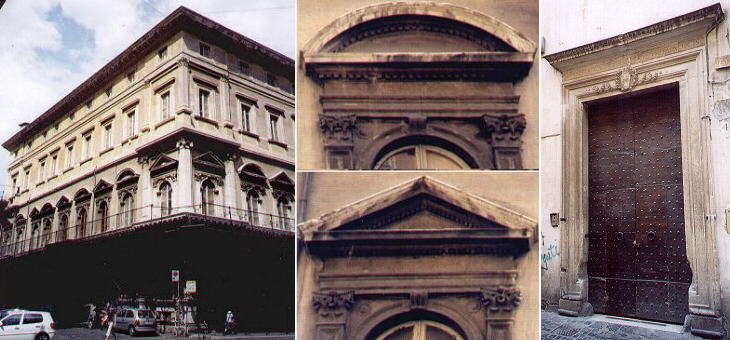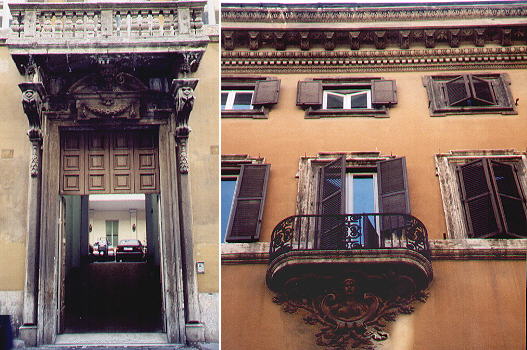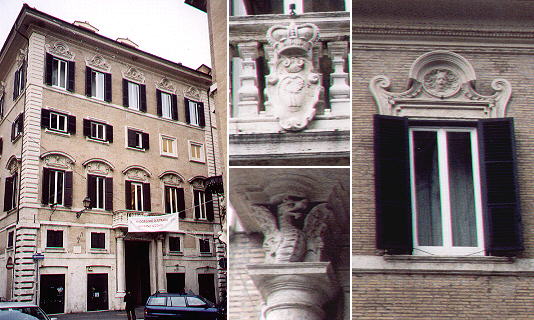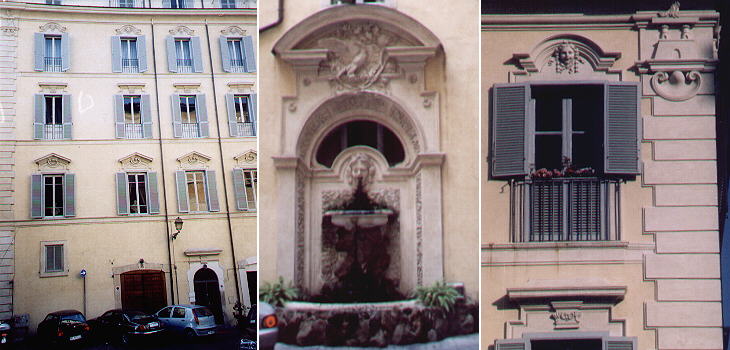  S. Maria in Vallicella (Book 7) (Map C2) (Day 4) (View D5) (Rione Ponte) and (Rione Parione)
In this page:
The church is also known as the Chiesa Nuova (new church), although it was built in 1605 and many other churches were built after this. Vallicella means small valley. Today it is not possible to appreciate this fact but the church is actually close to a small hill (Monte Giordano). The view is taken from the green dot in the 1748 map below. In the description below the plate Vasi made reference to: 1) Oratorio dei Filippini; 2) Palazzo Sforza Cesarini. 2) is shown in another page. The map shows also 3) Piazza dell'Orologio; 4) S. Maria in Vallicella; 5) Palazzo di Sora; 6) Palazzo Boncompagni Corcos; 7) Palazzo Cerri; 8) Palazzo Capponi Stampa; 9) Palazzo Caccialupi. The dotted line in the small map delineates the border between Rione Ponte (upper part), Rione Regola (left lower quarter) and Rione Parione (centre).
The piazza opposite the church is now crossed by a large street (Corso Vittorio Emanuele). A recent redesign of the piazza prevents cars from parking in front of the monuments. A low fountain was moved here in 1924 from Campo di Fiori. The Church
The church was built by S. Filippo Neri at the expense of Cardinal Cesi, thus no coat of arms or other heraldic reference to the pope is
identifiable in the sober fašade by Fausto Rughesi. You can see the fine ceiling of the church in a page covering
the ceilings of many Roman churches.<
The Monastery or Oratorio dei Filippini is another work by Borromini clearly admired by Vasi.
The sophisticated curved lines which Borromini so much liked animate the solid yet complex fašade.
As in all Borromini's works attention to details is extreme.
The main window is the object of a lavish decoration. The tower on
the back (Piazza dell'Orologio) plays with curves in the winter sun. At the corner with Via del Governo Vecchio there is one of the nicest XVIIIth century "Madonnella" (little altar dedicated to the Virgin Mary) by Tommaso Righi and Antonio Bicchierari.
Palazzo di Sora
Palazzo di Sora was built at the beginning of the XVIth century maybe by Donato Bramante.
It was considered a sort of architectural grammar because its windows showed the three classical orders.
Unfortunately the palace stood exactly where in the late XIXth century was opened Corso Vittorio Emanuele,
linking the Vatican with the Capitol. Only half of the building was spared, what was left of the original
fašade is now one of the shorter sides of the building.
Palazzo Cerri, similarly to Palazzo di Sora lost nearly half of its original size and it got a new fašade overlooking Corso Vittorio Emanuele. The original entrance is in what today seems a narrow street, but at the time seemed a large one and thus was called Via Larga. It was opened in 1627. As a matter of fact if one looks at the 1748 map the street is larger than the other ones. The design of the palace is generally attributed to Francesco Peparelli. The images show the old entrance and a detail of the fašade.
In the second half of the XVIth century the Jews living in the Papal States, in addition to laws forcing them to live in restricted areas in Rome and Ancona, had to face a strong pressure aimed at converting them to the Christian faith. In 1572 the rich Jew Solomon Corcos abandoned his faith and his name and became Gregorio Boncompagni after the name of Gregorius XIII Boncompagni. His heirs built in the XVIIth century an elegant palace in Piazza dell'Orologio. The palace is decorated with the dragons of the Boncompagni.
In his guide of Rome, Vasi mentions tre magnifici palazzi (three magnificent palaces) in Piazza dell'Orologio. The most famous one was Palazzo di Santo Spirito, designed by Borromini as headquarters for
Banco di S. Spirito, the papal bank. Eventually the offices of the bank were located in another palace by the same name and the palace built by Borromini
was bought by Cardinal Spada. Unfortunately in the XIXth century it was almost totally modified and only the courtyard retains some traces of the old building.
Next plate in Book 7: Chiesa di S. Maria Maddalena Next step in Day 4 itinerary: Chiesa di S. Tommaso in Parione Next step in your tour of Rione Ponte: Chiesa dei Santi Celso e Giuliano Next step in your tour of Rione Parione: Chiesa di San Tommaso in Parione  or to Book 7 or to
The Coats of Arms of the Popes or
to My Home Page on Baroque Rome or to
My Home Page on Rome in the footsteps of an XVIIIth century traveller or to Book 7 or to
The Coats of Arms of the Popes or
to My Home Page on Baroque Rome or to
My Home Page on Rome in the footsteps of an XVIIIth century traveller
|
All images © 1999 - 2003 by Roberto Piperno. Write to romapip@quipo.it
